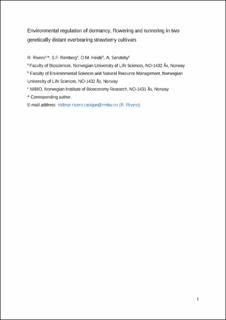| dc.description.abstract | The environmental control of dormancy and its relation to flowering and runner formation is poorly understood in everbearing (EB) strawberry cultivars. We studied the topic by growing plants of the seed-propagated F1-hybrid ‘Delizzimo’ and the runner-propagated ‘Favori’ cultivar in daylight phytotron compartments under short day (SD) and long day (LD) conditions at temperatures of 6, 16 or 26 °C for 5 and 10 weeks. This was followed by forcing at 20 °C and 20-h photoperiod for 10 weeks with and without preceding chilling at 2 °C for 6 weeks. The results showed that dormancy in EB strawberry is regulated by a complex interaction of temperature, photoperiod and chilling in much the same way as known for seasonal flowering (SF) cultivars. Surprisingly, the EB cultivars exhibited the same SD dormancy induction response as SF cultivars, despite their opposite photoperiodic flowering requirements. However, at 26 °C the EB cultivars developed partial dormancy also under LD conditions. As known for SF cultivars, none of the EB cultivars became dormant at 6 °C regardless of daylength conditions, whereas they were increasingly sensitive to SD dormancy induction at intermediate and high temperatures. Similar to SF cultivars, the EB cultivars needed exposure to SD and relatively high temperatures for at least 10 weeks for attainment of the semi-dormant state that is typical for strawberry in general. As reported for SF cultivars, there was a close interrelation between the control of flowering, runner formation and dormancy also in the EB cultivars. ‘Favori’ had an obligatory LD requirement for flowering at 26 °C and was almost day neutral at 16 °C, while ‘Delizzimo’ behaved as a quantitative LD plant at both temperatures, and both cultivars were completely day neutral at 6 °C. Except for the stricter LD control of flowering in ‘Favori’, the overall environmental responses were quite similar in the two genetically distant cultivars. Chilling for six weeks at 2 °C was adequate for complete reversal of the constrained elongation of leaf petioles and flower trusses in dormant plants, but had little or no effect on the degree of flowering and runner formation. | |
